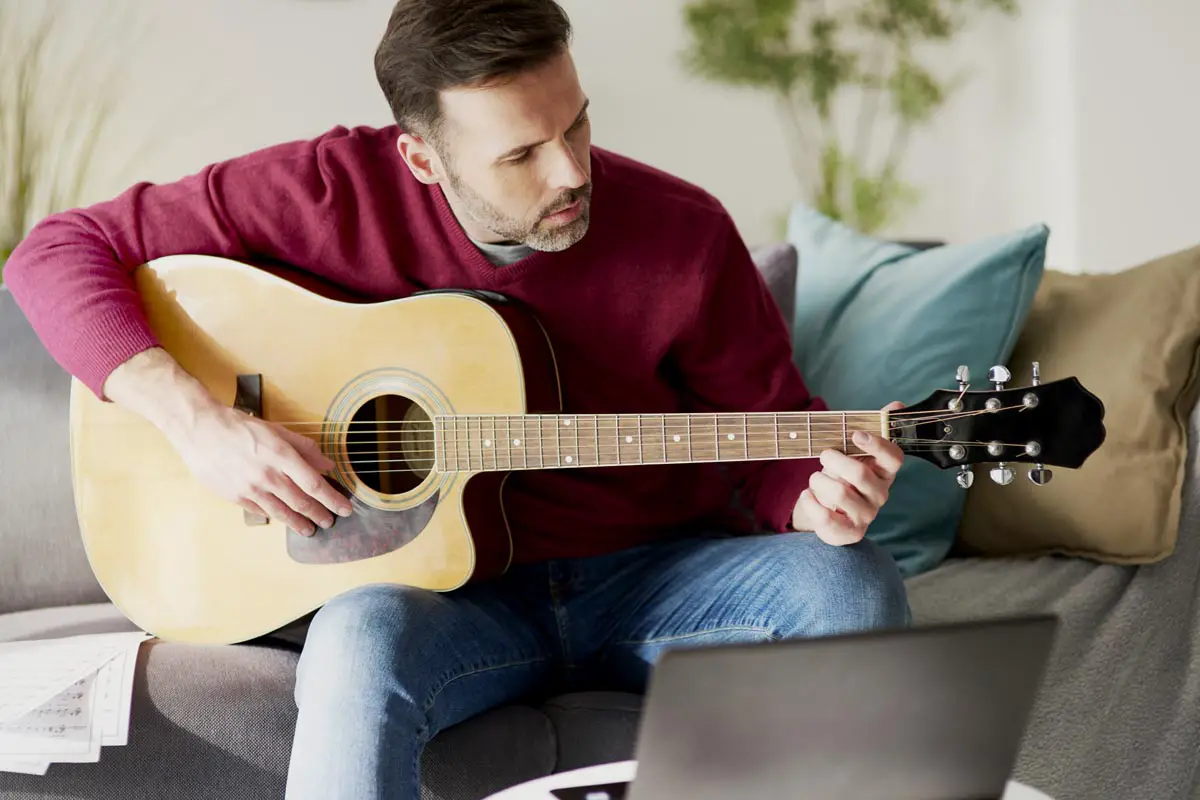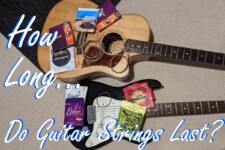Guitar Tips for Older Beginners (Make Learning Guitar Easier)
The joys of guitar should not be reserved exclusively for long haired punks still riding out their teenage years. Everyone should be able to and can, learn how to play the guitar, no matter their age.
No matter how old you are learning guitar takes time and patience. They’ll be days of frustration where you’ll regret ever having picked up the instrument but the satisfaction of nailing one of your favorite riffs or playing along to a record you love makes it all worthwhile.
One of the difficult things with learning guitar later in life (particularly for men), is that you become more judgemental of your performance levels, and high expectations can lead to frustration and feelings of failure.
If you want to embark on your guitar journey then there are a few things you should know before you get started. These tips will help guide you towards achievable goals and teach you the most effective ways to spend your practice time.

#1 Choose the Right Guitar To Learn On
The first and biggest decision to make is what type of guitar you want to get. Your choices are:
- Nylon String Acoustics.
- Steel String Acoustics.
- Electric Guitars.
Which one you pick comes down to two important factors; how comfortable you want the first few weeks of learning to be, and what sort of music you want to play.
Nylon String Guitars
For a gentle way to introduce your fingers to guitar your best bet is a nylon string acoustic. Nylon strings are the softest strings you’ll find on a guitar and won’t leave your fingers blistered no matter how long you practice.
They’re great for playing classical guitar and often feature wider necks to make it easier to distinguish each note from the other. They are on the quieter side though so don’t expect to be busting out any numbers to a crowd of people.
Steel String Guitars
A steel-string acoustic guitar is great if you want to learn the classics and picture yourself pulling out your guitar around the campfire once you’ve got a few tunes under your belt.
The downside of starting on a steel-string acoustic is that it’s probably going to hurt your fingertips at first. Steel strings give you more amplification and a more robust sound at the expense of your fingertips.
While this might sound strange you have to wait for your fingers to callus a bit before it gets comfortable. Get through this once and the pain will be a distant memory as you fill a room with classic acoustic guitar anthems.
Electric Guitars
You won’t be Jimmy Page immediately but if that’s where you want to head then an electric guitar is probably what you’ve been looking to get.
While they also use steel strings they aren’t as thick as the ones found on steel-string acoustics so it’s not as rough on your fingers from the get-go. Electric guitars also have the bonus of being able to practice with headphones without worrying about what your neighbors think.
For your first guitar don’t worry about brands and parts too much, just get something that sounds alright while you get a feel for the instrument. After playing for a while you’ll get a feel for what you like and dislike about your first guitar and be able to make a more informed decision when it comes time to upgrade.
The only thing I’d look out for is making sure the action isn’t too high. Action refers to the distance between the fretboard and the strings. If the strings sit too far away from the frets it can make pressing the strings down properly difficult even for seasoned players.
#2 Don’t Rush Each Step – Take Your Time
It can be very tempting to rush ahead of yourself every time you think you’ve learned something new. Instead take your time with each step, each new chord, each new song. Make sure you know it like the back of your hand before moving on to learning something else.
Each thing you learn about guitar is like adding a new building block to your arsenal, and will come in handy as you progress. If you half-arse what you learn it will come back to bite you when next you go to learn something.
This process of thinking you’ve mastered something only to move on and realize you have to go back to relearn it only leads to frustration, because you feel you’re not learning. In reality, you just didn’t take the time to fully learn what came before.
#3 Dealing With Frustration & Expectation
Setting realistic goals for yourself is key to becoming a great guitarist. If you dream too big too fast you’ll only hinder your progress by not feeling like you’re progressing fast enough.
Learning the guitar is a process that can take years and it’s good to understand that you probably won’t be a pro a few months in. This is all part of picking up an instrument.
Remember, each day you sit down and dedicate some time to practice you become a better guitarist than the day before, even if just a little bit.
As you become more familiar with the guitar things that seemed challenging to begin with start to feel natural.
If something you are learning is becoming frustrating, just put the guitar down and walk away; you’ll be surprised after doing this 2-3 times in a day how much you have progressed.
Learning to play music is like learning a new language it all seems alien at first until one day without realizing you will intuitively be better without realizing it.
#4 Decide What You Would Like to Play – Be Realistic
As you start to learn you should be looking for songs that are achievable for beginners to play!
A great resource to figure out if a song you want to play is within your skill level is guitar tab website UltimateGuitar.com where most tabs have a difficultly level assigned to them at the top of the tab.
This way you can see what level of difficulty the author of the tab thinks their tab is. So instead of researching what songs are good to learn for beginners, you can search up songs you love and see if they’d be good to learn!
This way you learn songs at a level that is realistic but also get the chance to learn songs you have picked yourself which is far more enjoyable and gives you a sense of control and achievement.
Starting off, choose songs with easy open chords, and simple strumming patterns.
#5 Find A Lesson Path To Reach Your Guitar Goals
With the abundance of information on the internet, there are now more ways to learn the guitar than ever before, so you’re sure to find a method that works for you even if it takes a bit of trial and error.

YouTube Learning
Youtube is one of the greatest learning resources the world has ever had. On Youtube, there is no shortage of free guitar teachers with videos ranging from lessons on technique to dedicated tutorials for nearly every song ever written.
Best of all it’s completely free. If you find a Youtube channel with a teacher that you like there’s a chance you’ll never have to attend a guitar lesson in your life. So have a browse of YouTube and try a few different channels to see if one suits you.
Learning with JustinGuitar.com
For a more formally structured way to approach the YouTube method of learning, there is Justin Guitar. Justin was a Youtuber before starting his own website that aims to teach new and experienced players the skills they need to become great at the guitar.
With over 1800 tutorials Justin can take you from the initial steps of getting comfortable with your instrument to learning advanced techniques.
The caveat is that Justin Guitar is a subscription based service but for your money, you will be getting a more polished and structured learning experience than free Youtube videos.
Learning with Private Lessons
If you’re looking for a more old-school and hands on approach there is always the option of private lessons with a guitar teacher. The best part about private lessons is that you have an experienced guitarist in the room with you that can give you one-on-one feedback as you learn.
While following along with an online video is a great alternative; for some people, nothing beats having someone there to guide you and let you know what you’re doing right and doing wrong.
#6 Warm up each Day For A Few Minutes
Limbering up your fingers is key to getting them in shape for playing. Simply wiggling your fingers around like you’re performing a magic trick is more than enough to get them flexible.
This is especially important if you do a lot of work on a computer and your fingers are stiff after a day of typing on a keyboard.
Next, it’s a great idea to noodle around with a few easy exercises to get your fingers used to the feel of your guitar before attempting to learn something new.
A great exercise to memorize for warm ups is the finger skipping exercise.
This involves:
- Playing the first fret of each string one after another and then back again when you reach the last string.
- For the first fret use your first finger. Once you’ve gone across the fretboard and back, move to the second fret; this time use your second finger and repeat the same pattern.
- Next, move to the 3rd fret with your 3rd finger, repeating again and finally move to the 4th fret using your 4th finger.
Repeat this a few times until your comfortably using all your fingers to navigate the fretboard. This will help you prepare to use all your fingers while playing instead of just your index and middle finger (a common beginner’s mistake).
#7 Learn In Short Bursts
While it can be tempting to keep practicing and push through the frustration of mistakes you’re not doing yourself any favors.
Like all skills, the law of diminishing returns means that anything you learn after 15 minutes of practice will be far harder to absorb. Because of this, it’s best to practice in short dedicated bursts.
That doesn’t mean you should only practice 15 minutes a day, instead take breaks between those shorter sessions to give your brain a chance to process what you’ve learned.
Learning like this is a big secret to learning faster, and makes learning guitar easier since your brain commits what you just learnt to permanent memory while you are taking a break.
#8 Listen to the Music You Want to Learn
As you learn guitar you will become better at listening to the guitar parts of the songs you are learning.
The more familiar you become with the guitar part in the song, the more accurately you’ll be able to follow along when you learn it. A common mistake is thinking you know the cadence of the song you are learning, when in fact what is being played is different from how you recall it.
This most commonly appears in the form of hearing ‘ghost notes’ usually double notes that aren’t actually in the song. This can lead you to try playing the song incorrectly which will lead to confusion when your timing is off.
Listen to the songs you want to learn as much as you can, and the melodies and nuances of the music will etch themselves into your head, making it easier to get the same feel when you play.
#9 Go for Some Quick Wins
Feeling like you’re making progress is important for the psychology of learning. Don’t force yourself to learn songs that are too difficult for your skill level as you’ll only burn out.
Pick some easy classics to get under your belt this will give you a sense of accomplishment and motivate you to keep practicing.
#10 Practice Time Is Practice Time
Picking up your guitar and messing around is not practicing. While it’s fun it doesn’t do much to approve your skills.
Targeting your practice sessions will give you better results. Pick a specific area of practice, something whereby the end of your practice you will have improved a skill or learned a new song.
Noodling around is fine as long as it’s not the only time you’re spending with your instrument.
#11 Don’t Just Learn Parts of Songs
Learning entire songs will teach you discipline.
Only learning the cool intro riff or solo is fun, but it won’t yield the benefits of learning how to maneuver your whole fretboard to perform an entire song.
A great goal to set for a beginner is to build a repertoire of 10 songs that you know by heart. Learning entire songs will help you train your ear to what chords and progressions work together; something you won’t pick up learning disjointed parts.




